Application of a Standardized Precipitation Index for Meteorological Drought Analysis of the Semi-Arid Climate Influence in Minas Gerais, Brazil
Abstract
:1. Introduction
2. Materials and Methods
3. Results and Discussion
3.1. Drought Events
3.2. Severity-Duration-Frequency Curves
3.3. Isohyetal Maps for Drought Analysis
4. Conclusions
Acknowledgments
Author Contributions
Conflicts of Interest
References
- Rahmat, S.N. Methodology for Development of Drought Severity-Duration-Frequency (SDF) Curves. Ph.D. Thesis, School of Civil, Environmental and Chemical Engineering, RMIT University, Melbourne, Australia, 2015. [Google Scholar]
- Ogallo, L.A. Drought and desertification: An overview. In Bulletin of the World Meteorological Organization; World Meteorological Organization: Geneva, Switzerland, 1994; Volume 1, p. 43. [Google Scholar]
- Gathara, S.T.; Gringof, L.G.; Mersha, E.; Sinha RAY, K.C.; Spasov, P. Impacts of desertification and drought and other extreme meteorological events. In WMO/TD 1343; World Meteorological Organization: Geneva, Switzerland, 2006. [Google Scholar]
- Dalezios, N.R.; Loukas, A.; Vasiliades, L.; Liakopoulos, E. Severity-duration-frequency analysis of droughts and wet periods in Greece. Hydrol. Sci. J. 2000, 45, 751–769. [Google Scholar] [CrossRef]
- McKee, T.B.; Doesken, N.J.; Kleist, J. Drought monitoring with multiple timescales. In Proceedings of the 8th Conference on Applied Climatology, Anaheim, CA, USA, 17–22 January 1993. [Google Scholar]
- Valipour, M. How Much Meteorological Information Is Necessary to Achieve Reliable Accuracy for Rainfall Estimations? Agriculture 2016, 6, 53. [Google Scholar] [CrossRef]
- Van Loon, A.F. Hydrological drought explained. Wiley Interdiscip. Rev. 2015, 2, 359–392. [Google Scholar] [CrossRef]
- Mello, C.R.; Viola, M.R.; Coelho, G.; Norton, L.D. Droughts in Southern Minas Gerais, Southeastern Brazil: Understanding the Last 100 Years. In Proceedings of the 10th International Symposium on Agriculture and the Environment, Purdue University, West Lafayette, IN, USA, 23–27 May 2016. [Google Scholar]
- Rajsekhar, D.; Singh, V.P.; Mishra, A.K. Hidrologic Drought Atlas for Texas. J. Hydrol. Eng. 2014, 20, 05014023. [Google Scholar] [CrossRef]
- Valipour, M. Ability of Box-Jenkins Models do Estimate of Reference Potential Evapotranspiration (A Case Study: Mehrabad Synoptic Station, Tehran, Iran). J. Agric. Vet. Sci. 2012, 1, 1–11. [Google Scholar]
- Valipour, M. Analysis of potential evapotranspiration using limited weather data. Appl. Water Sci. 2017, 7, 187–197. [Google Scholar] [CrossRef]
- Valipour, M. Hydro-Module determination for Vanaei village in Eslam Abad Gharb, Iran. J. Agric. Biol. Sci. 2012, 7, 968–976. [Google Scholar]
- Valipour, M. Variations of land use and irrigation for next decades under different scenarios. Irriga 2016, 1, 262–288. [Google Scholar] [CrossRef]
- Valipour, M. Use of Surface Water Supply Index to assessing of water resources management in Colorado and Oregon, US. Adv. Agric. Sci. Eng. Res. 2013, 3, 631–640. [Google Scholar]
- Valipour, M. Necessity of Irrigated and Rainfed Agriculture in the World. Irrig. Drain. Sys. Eng. 2013, 9, e001. [Google Scholar] [CrossRef]
- Valipour, M. Land use policy and agricultural water management of the previous half of century in Africa. Appl. Water Sci. 2015, 5, 367–395. [Google Scholar] [CrossRef]
- Valipour, M. Evolution of Irrigation-Equipped Areas as Share of Cultivated Areas. Irrig. Drain. Sys. Eng. 2013, 2, e114. [Google Scholar] [CrossRef]
- Brazilian Institute of Geography and Statistics (IBGE). Estados IBGE. Available online: http://www.ibge.gov.br/estadosat/perfil.php?lang=&sigla=mg (accessed on 02 February 2016).
- Sá Junior, A.; Carvalho, L.G.; Silva, F.F.; Carvalho Alves, M. Application of the Köppen classification for climatic zoning in the state of Minas Gerais, Brazil. Theor. Appl. Climatol. 2012, 108, 1–7. [Google Scholar] [CrossRef]
- Brazilian National Water Agency (ANA). HidroWeb—Sistema de Informações Hidrológicas. Available online: http://www.hidroweb.ana.gov.br (accessed on 15 August 2016).
- Teodoro, P.E.; Guedes Corrêa, C.C.; Torres, F.E.; Oliveira Junior, J.F.; Silva Junior, C.A.; Gois, G.; Coll Delgado, R. Analysis of the Occurrence of Wet and Drought Periods Using Standardized. J. Agron. 2015, 14, 80–86. [Google Scholar]
- Svoboda, M.; Hayes, M.; Wood, D. Standardized Precipitation Index—User Guide; World Meteorological Organization (WMO): Geneva, Switzerland, 2012. [Google Scholar]
- Edwards, D.C. Characteristics of 20th Century Drought in the United States at Multiple Time Scales. Master Thesis, Colorado State University, Fort Collins, CO, USA, 1997. [Google Scholar]
- Santos, J.F.; Portela, M.M.; Pulido-Calvo, I. Regional frequency analysis of droughts in Portugal. Water Resour. Manag. 2011, 25, 3537–3558. [Google Scholar] [CrossRef]
- Volkova, T.; Afanasev, I.; Longobardi, A.; Alexey, E. Gamma distribution function as a tool for monthly precipitation generation in the Bashkortostan Republic, Russian Federation. In Latest Trends in Energy, Environment and Development, Proceedings of the 7th International Conference on Environmental and Geological Science and Engineering (EG ’14), Proceedings of the 7th International Conference on Urban Planning and Transportation (UPT ’14), Proceedings of the 3rd International Conference on Energy Systems, Environment, Entrepreneurship and Innovation (ICESEEI ’14), Salerno, Italy, June 3–5, 2014; WSEAS Press: Salerno, Italy, 2014. [Google Scholar]
- Thom, H.C. A note on the gamma distribution. Mon. Weather Rev. 1958, 86, 117–122. [Google Scholar] [CrossRef]
- Stephens, M.A. EDF Statistics for Goodness of Fit and Some Comparisons. J. Am. Stat. Assoc. 1974, 69, 730–737. [Google Scholar] [CrossRef]
- Fiedler, F.R. Simple, practical method for determining station weights using Thiessen polygons and isohyetal maps. J. Hydrol. Eng. 2003, 4, 219–221. [Google Scholar] [CrossRef]



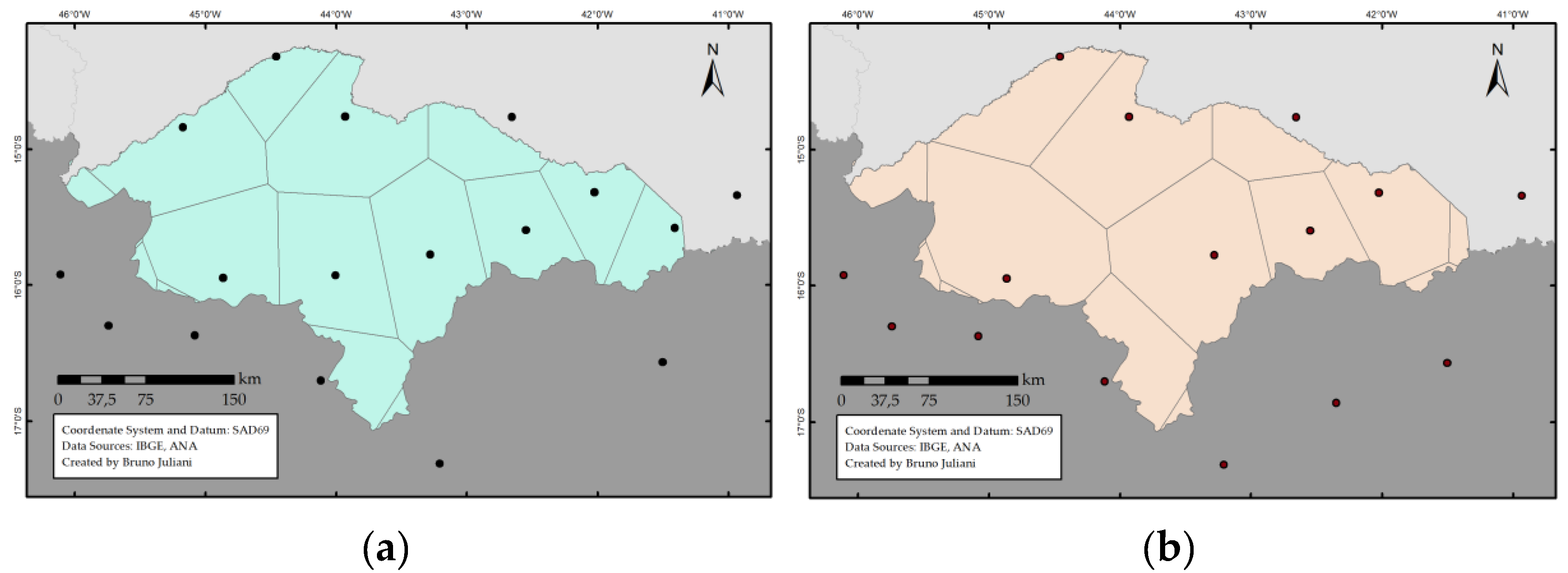
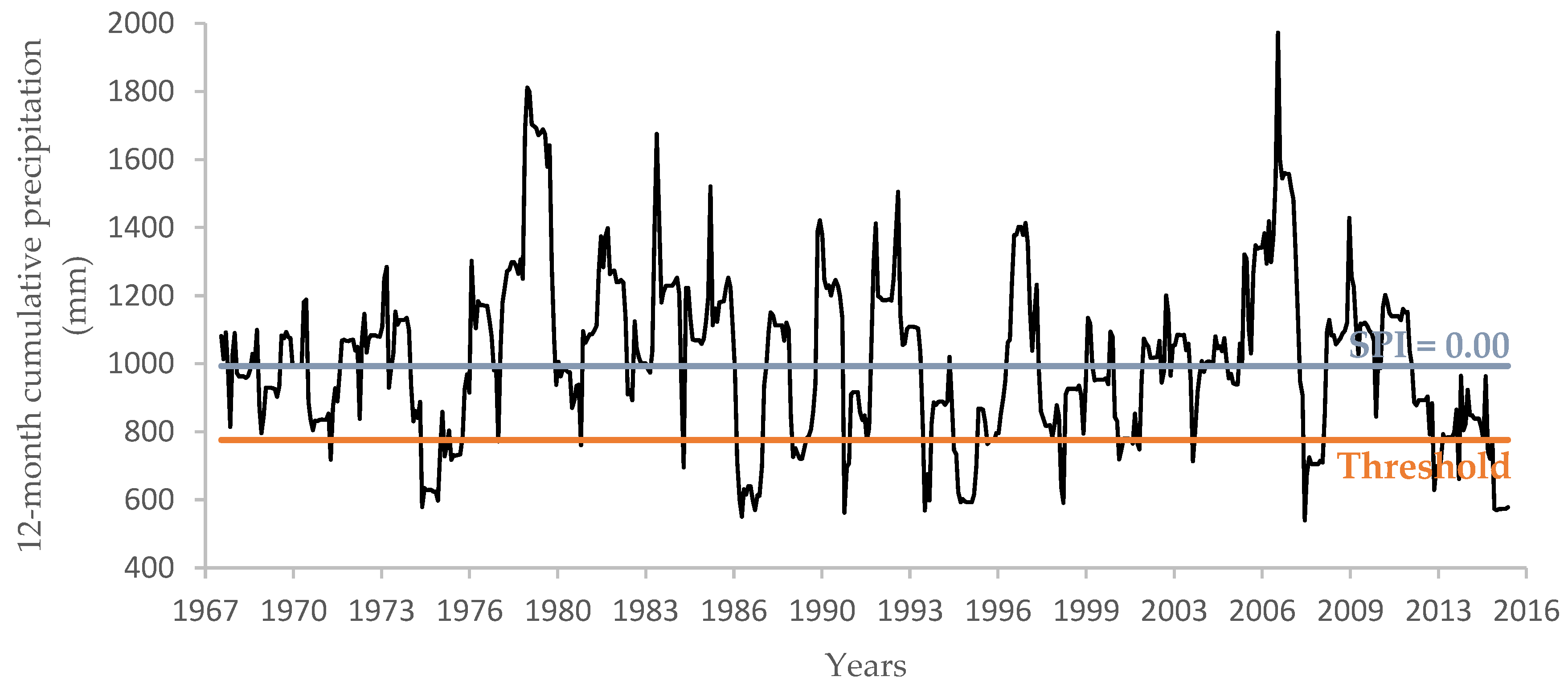

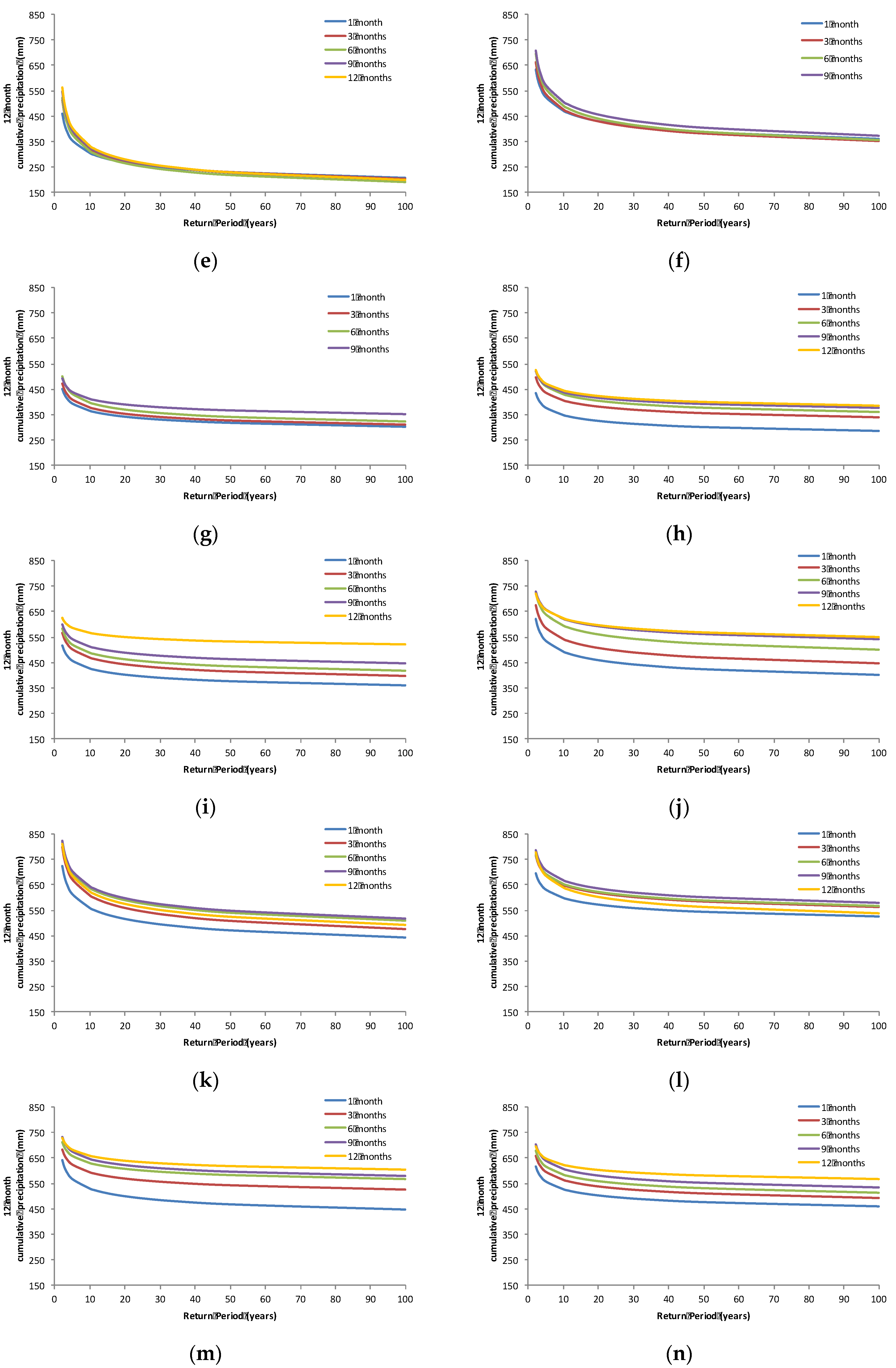
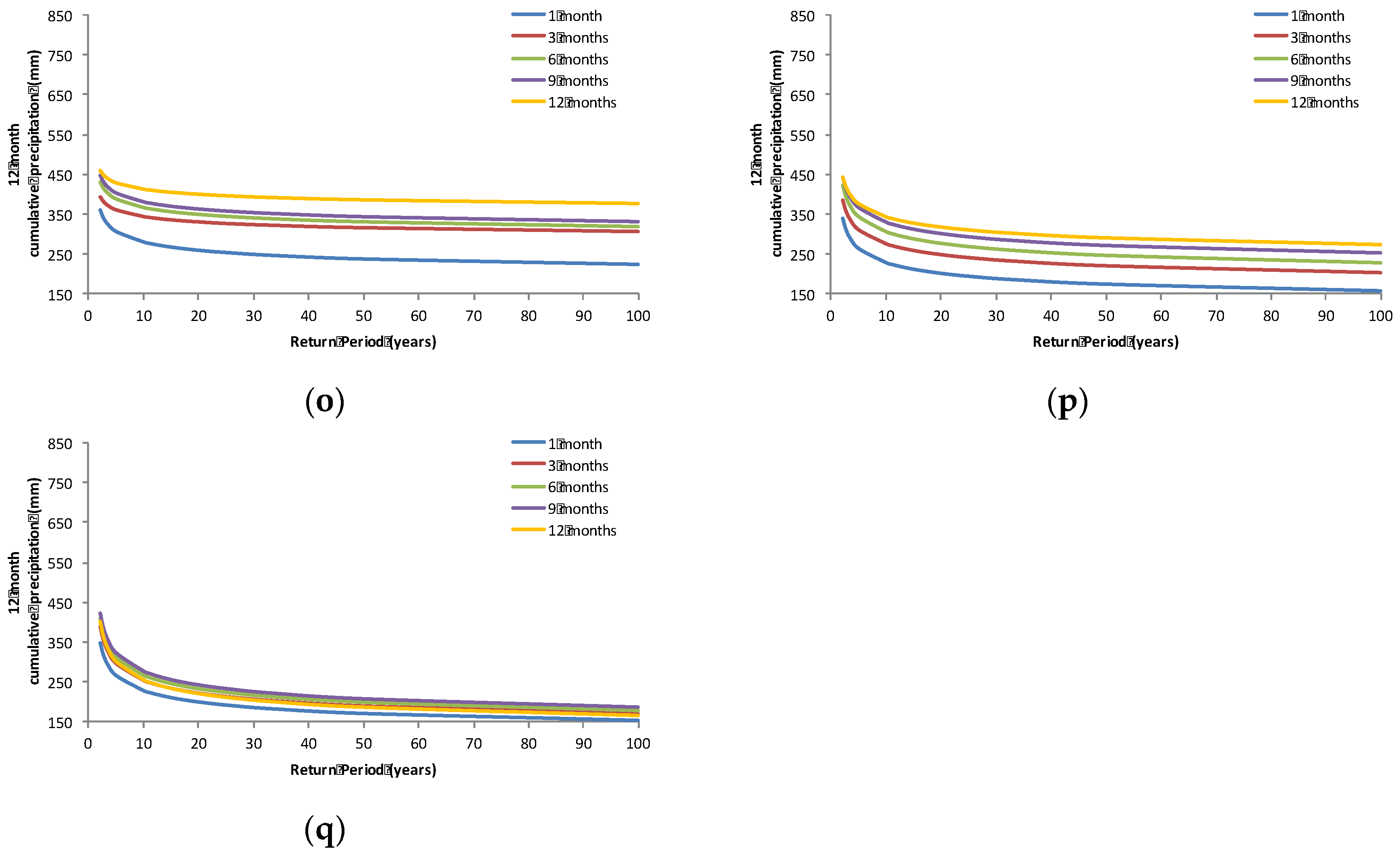
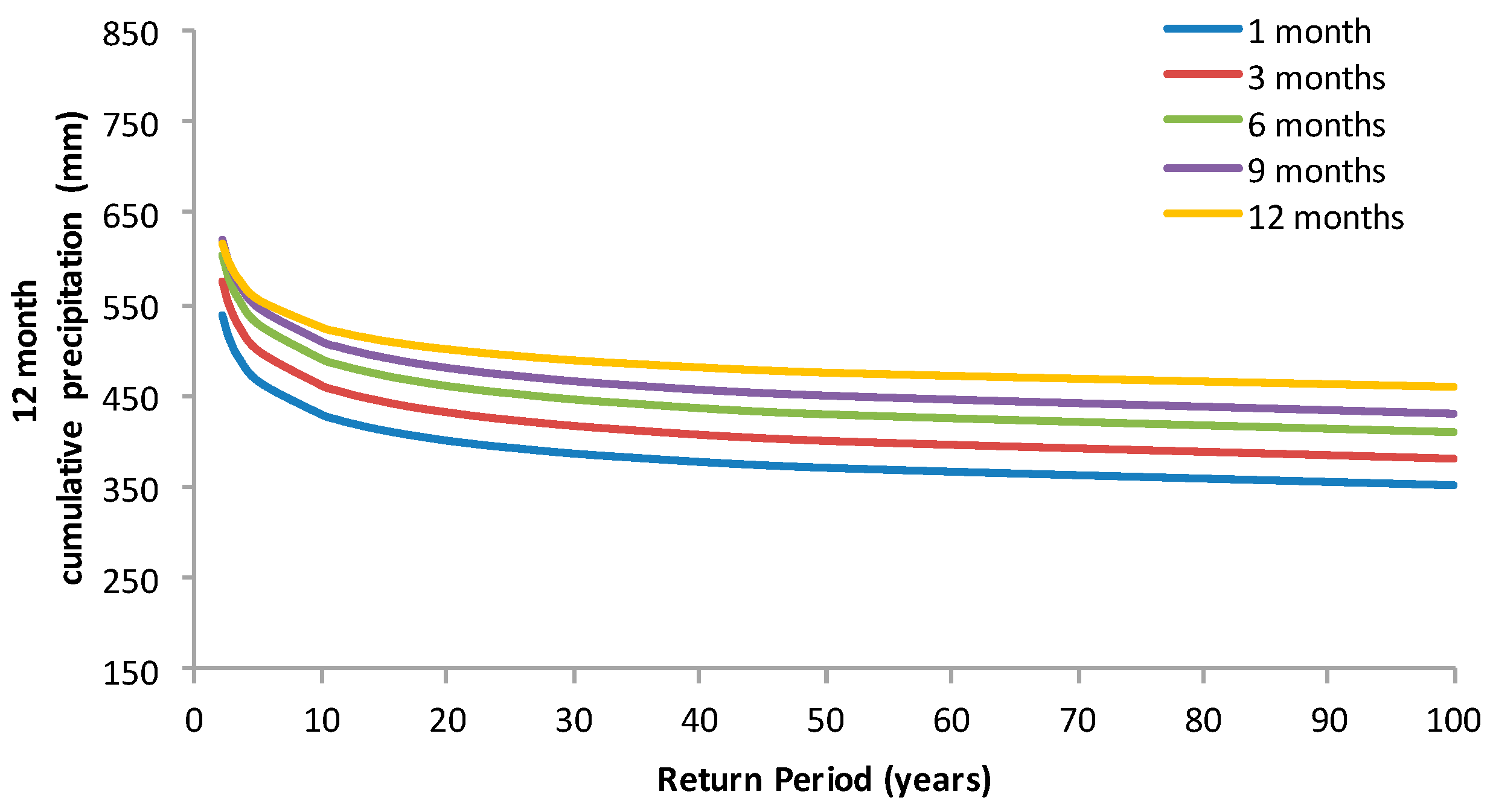

| SPI Values | Category | Normal Distribution Cumulated Probabilities |
|---|---|---|
| 0.00 to −0.99 | Near normal | 0.500 |
| −1.00 to −1.49 | Moderate drought | 0.158 |
| −1.50 to −1.99 | Severe drought | 0.066 |
| −2.00 and less | Extreme drought | 0.022 |
| Station | Threshold Level (mm) | Number of Events of Drought | ||||
|---|---|---|---|---|---|---|
| 1-Month Duration | 3-Month Duration | 6-Month Duration | 9-Month Duration | 12-Month Duration | ||
| São Francisco | 775.7 | 15 | 12 | 10 | 10 | 6 |
| São João da Ponte | 748.0 | 12 | 8 | 8 | 8 | 4 |
| Janaúba | 572.6 | 12 | 10 | 8 | 8 | 7 |
| Manga | 632.9 | 19 | 16 | 14 | 12 | 7 |
| São Gonçalo | 634.4 | 12 | 11 | 9 | 9 | 8 |
| Cajueiro | 763.3 | 6 | 5 | 5 | 5 | 3 |
| Itamarati | 549.9 | 15 | 11 | 9 | 8 | 4 |
| São João do Paraíso | 540.8 | 14 | 13 | 13 | 11 | 8 |
| Rio Pardo de Minas | 645.3 | 12 | 11 | 9 | 8 | 5 |
| Vila Terra Branca | 792.5 | 13 | 11 | 11 | 10 | 6 |
| Arinos Montante | 890.3 | 14 | 14 | 13 | 12 | 8 |
| Vila Urucuia | 833.5 | 14 | 13 | 10 | 10 | 5 |
| São Romão | 797.4 | 16 | 14 | 13 | 13 | 7 |
| São João da Vereda | 757.2 | 12 | 11 | 9 | 9 | 7 |
| Urandi | 484.1 | 11 | 9 | 8 | 8 | 6 |
| Inhobim | 493.1 | 12 | 11 | 9 | 9 | 6 |
| Itaobim | 489.7 | 12 | 12 | 11 | 11 | 7 |
| Ranked Events | Cumulative 12-Month Average Precipitation (mm) | ||||
|---|---|---|---|---|---|
| 1-Month Duration | 3-Month Duration | 6-Month Duration | 9-Month Duration | 12-Month Duration | |
| 1 | 539.5 | 571.6 | 572.6 | 606.3 | 623.3 |
| 2 | 550.3 | 592.8 | 594.7 | 611.3 | 654.1 |
| 3 | 562.2 | 593.3 | 612.4 | 612.1 | 665.7 |
| 4 | 569.1 | 613.7 | 620.5 | 631.9 | 669.5 |
| 5 | 569.7 | 614.1 | 675.5 | 687.0 | 812.4 |
| 6 | 578.8 | 645.7 | 734.0 | 752.9 | 861.9 |
| 7 | 590.9 | 655.1 | 738.4 | 774.3 | |
| 8 | 592.8 | 712.7 | 763.7 | 788.4 | |
| 9 | 695.4 | 725.4 | 784.7 | 813.0 | |
| 10 | 713.7 | 748.1 | 819.5 | 855.9 | |
| 11 | 717.9 | 810.4 | |||
| 12 | 718.5 | 839.6 | |||
| 13 | 721.0 | ||||
| 14 | 760.5 | ||||
| 15 | 771.6 | ||||
| Exceedance Probability | Average Recurrence Interval (years) | Cumulative 12-Month Precipitation (mm) | ||||
|---|---|---|---|---|---|---|
| 1-Month Duration | 3-Month Duration | 6-Month Duration | 9-Month Duration | 12-Month Duration | ||
| 1% | 100.00 | 468.4 | 497.2 | 512.0 | 521.2 | 527.8 |
| 2% | 50.00 | 486.7 | 516.0 | 530.8 | 541.2 | 547.4 |
| 3% | 33.33 | 498.5 | 528.2 | 543.0 | 554.2 | 560.0 |
| 4% | 25.00 | 507.5 | 537.5 | 552.4 | 564.2 | 569.7 |
| 5% | 20.00 | 515.0 | 545.1 | 560.0 | 572.3 | 577.7 |
| 6% | 16.67 | 521.3 | 551.7 | 566.6 | 579.3 | 584.5 |
| 7% | 14.29 | 527.0 | 557.5 | 572.4 | 585.5 | 590.5 |
| 8% | 12.50 | 532.1 | 562.7 | 577.6 | 591.1 | 595.9 |
| 9% | 11.11 | 536.7 | 567.5 | 582.4 | 596.2 | 600.9 |
| 10% | 10.00 | 541.0 | 571.9 | 586.8 | 600.9 | 605.5 |
| 20% | 5.00 | 573.7 | 605.5 | 620.4 | 636.9 | 640.4 |
| 30% | 3.33 | 598.1 | 630.5 | 645.4 | 663.6 | 666.4 |
| 40% | 2.50 | 619.5 | 652.5 | 667.3 | 687.1 | 689.2 |
| 50% | 2.00 | 640.0 | 673.4 | 688.2 | 709.5 | 710.9 |
| 60% | 1.67 | 660.9 | 694.8 | 709.6 | 732.5 | 733.1 |
| 70% | 1.43 | 683.8 | 718.2 | 732.9 | 757.5 | 757.4 |
| 80% | 1.25 | 711.2 | 746.2 | 760.8 | 787.6 | 786.5 |
| 90% | 1.11 | 750.4 | 786.3 | 800.7 | 830.5 | 828.0 |
| 91% | 1.10 | 755.8 | 791.8 | 806.2 | 836.4 | 833.7 |
| 92% | 1.09 | 761.6 | 797.8 | 812.1 | 842.9 | 839.9 |
| 93% | 1.08 | 768.1 | 804.4 | 818.7 | 850.0 | 846.8 |
| 94% | 1.06 | 775.4 | 811.9 | 826.1 | 858.0 | 854.5 |
| 95% | 1.05 | 783.8 | 820.4 | 834.7 | 867.2 | 863.3 |
| 96% | 1.04 | 793.7 | 830.6 | 844.7 | 878.0 | 873.8 |
| 97% | 1.03 | 806.0 | 843.1 | 857.2 | 891.5 | 886.8 |
| 98% | 1.02 | 822.6 | 860.0 | 874.0 | 909.6 | 904.3 |
| 99% | 1.01 | 849.1 | 887.0 | 900.9 | 938.7 | 932.3 |
© 2017 by the authors. Licensee MDPI, Basel, Switzerland. This article is an open access article distributed under the terms and conditions of the Creative Commons Attribution (CC BY) license (http://creativecommons.org/licenses/by/4.0/).
Share and Cite
Juliani, B.H.T.; Okawa, C.M.P. Application of a Standardized Precipitation Index for Meteorological Drought Analysis of the Semi-Arid Climate Influence in Minas Gerais, Brazil. Hydrology 2017, 4, 26. https://doi.org/10.3390/hydrology4020026
Juliani BHT, Okawa CMP. Application of a Standardized Precipitation Index for Meteorological Drought Analysis of the Semi-Arid Climate Influence in Minas Gerais, Brazil. Hydrology. 2017; 4(2):26. https://doi.org/10.3390/hydrology4020026
Chicago/Turabian StyleJuliani, Bruno Henrique Toná, and Cristhiane Michiko Passos Okawa. 2017. "Application of a Standardized Precipitation Index for Meteorological Drought Analysis of the Semi-Arid Climate Influence in Minas Gerais, Brazil" Hydrology 4, no. 2: 26. https://doi.org/10.3390/hydrology4020026






